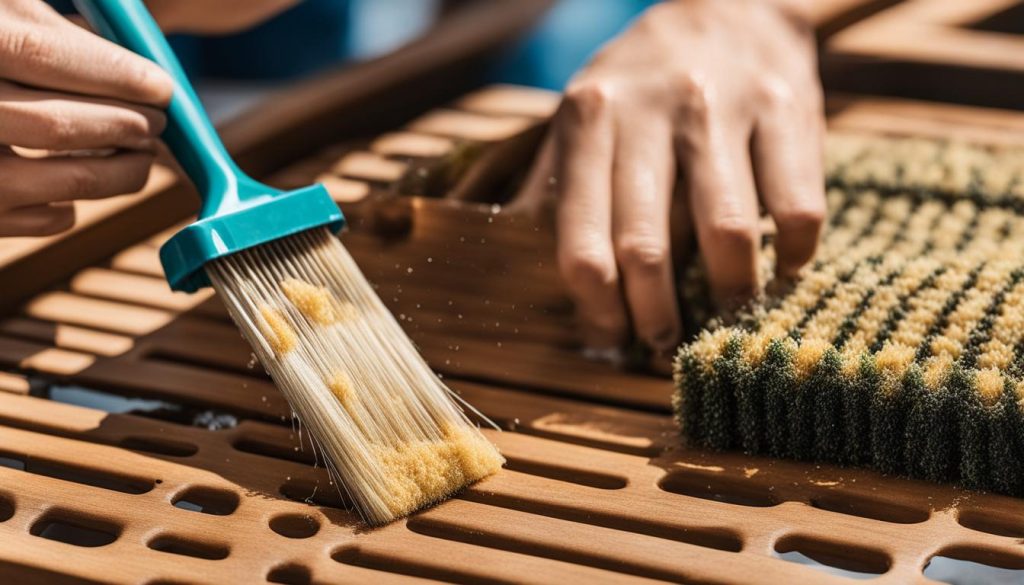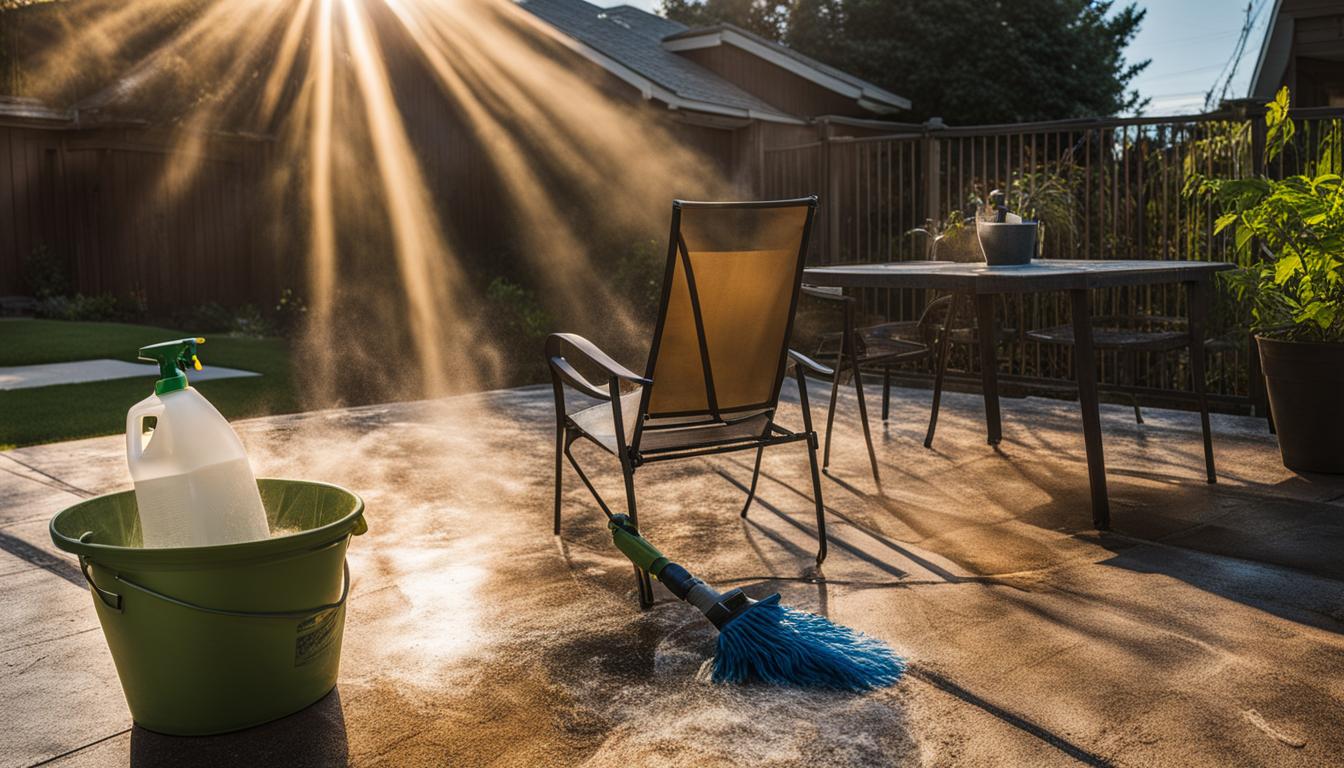Maintaining the cleanliness and appearance of your patio furniture mesh is essential to ensure its longevity and appeal. Regular cleaning can help remove dirt, stains, and grime, keeping your furniture looking fresh and inviting. In this section, I will share effective cleaning techniques for patio furniture mesh, offering you tips and guidance on how to keep it in pristine condition.
Key Takeaways
- Regular cleaning is important to maintain the appearance and prolong the lifespan of patio furniture mesh.
- Dishwashing soap and water can be used to create a lather that effectively removes grease and stubborn dust from the mesh.
- Water pressure can be a safe and effective method for removing dust and grime from patio furniture mesh.
- A solution of detergent and a soft brush can help remove stubborn stains, bird droppings, and sand deposits from the mesh.
- Vinegar is a natural cleanser that can be used to remove dirt and stains from patio furniture mesh.
Dishwashing Soap and Cloth
Dishwashing soap mixed with water is a simple yet effective solution for cleaning patio furniture mesh. The gentle yet powerful properties of dish soap help to remove grease and dust, leaving the mesh clean and refreshed. To begin, mix a small amount of dish soap with warm water in a bucket or container.
Next, dip a soft cloth or sponge into the soapy solution and wring out any excess liquid. Gently scrub the mesh surface, paying attention to areas with visible dirt or dust buildup. The soapy lather will help to break down and lift away any grime or debris.
Once you have thoroughly cleaned the mesh, rinse it with clean water to ensure all soap residue is removed. Allow the furniture to air dry completely before using it again. Regular cleaning with dishwashing soap and cloth will help maintain the appearance and longevity of your patio furniture mesh.
Benefits of Using Dishwashing Soap and Cloth
- Gentle yet effective cleaning solution for patio furniture mesh
- Removes grease and dust buildup
- Leaves the mesh clean and refreshed
- Easy to use and readily available
- Helps maintain the appearance and longevity of the mesh
Water Pressure
Another effective method for cleaning patio furniture mesh is by using water pressure. This method utilizes a pressure washer hose to deliver a forceful stream of water that can easily remove dust and grime from the surface of the mesh. By using medium pressure, you can ensure that the weave of the mesh is not damaged during the cleaning process.
Using water pressure to clean patio furniture mesh is a quick and efficient way to restore its cleanliness and appearance. The strong stream of water can reach deep into the mesh, dislodging any dirt or debris that may have accumulated over time. It is important to pay attention to any stubborn stains or areas of heavy grime and direct the stream of water towards those areas for a more thorough cleaning.
To effectively clean patio furniture mesh with water pressure, start by attaching the pressure washer hose to a water source and turning on the machine. Hold the hose at a distance of about one foot from the mesh and gradually move it across the surface, ensuring that the water covers the entire area. Take care not to stay in one spot for too long to prevent any potential damage to the mesh.
Benefits of Using Water Pressure
The use of water pressure for cleaning patio furniture mesh offers several benefits. Firstly, it is a time-saving method, as the forceful stream of water can quickly remove dirt and grime without the need for extensive scrubbing. Secondly, water pressure is a versatile cleaning technique that can be used on various types of mesh, including plastic, metal, and fabric. Lastly, it is a cost-effective option, as it eliminates the need for expensive cleaning agents or specialized tools.
However, it is important to exercise caution when using water pressure to clean patio furniture mesh. Excessive pressure or holding the nozzle too close to the mesh can cause damage to the weave or even dislodge the mesh from its frame. Therefore, it is recommended to start with medium pressure and gradually increase if necessary, while also maintaining a safe distance from the mesh.
Summary
Cleaning patio furniture mesh with water pressure is an effective and efficient method for removing dust and grime. By using a pressure washer hose and medium pressure, you can easily restore the cleanliness and freshness of the mesh. However, it is essential to exercise caution to prevent any damage to the mesh. Overall, water pressure offers a time-saving and cost-effective solution for maintaining the appearance of patio furniture mesh.
Detergent and a Soft Brush
When it comes to effectively cleaning patio furniture mesh, using a combination of detergent and a soft brush can work wonders. This method is particularly useful for removing stubborn stains from the mesh, ensuring that it looks fresh and rejuvenated. To start, mix a small amount of detergent with water to create a soapy solution.
Apply the soapy solution onto the stained areas of the mesh and let it sit for a few minutes to loosen the dirt and grime. Then, take a soft brush and gently scrub the surface of the mesh in circular motions. The bristles of the brush will help to agitate and remove the stains, revealing a cleaner mesh underneath.
After scrubbing, rinse the mesh with clean water to remove any remaining detergent residue. Make sure to thoroughly rinse the entire surface to prevent any potential damage. Allow the mesh to air dry completely before using or storing it to avoid the growth of mold or mildew.
This method of using detergent and a soft brush is a simple yet effective way to tackle stains and restore the appearance of your patio furniture mesh. It can be used on various types of mesh, but always check the manufacturer’s recommendations for any specific care instructions. Remember to test the detergent on a small, inconspicuous area before applying it to the entire mesh to ensure compatibility and avoid any potential damage.
Vinegar: A Natural Cleanser for Patio Furniture Mesh
Vinegar is a versatile and natural cleaning agent that can effectively remove dirt, stains, and odors from patio furniture mesh. Its acidic properties make it a powerful cleanser that can break down grime and restore the cleanliness of the mesh.
When using vinegar to clean patio furniture mesh, start by diluting it with water in a 1:1 ratio. This will ensure that the vinegar is not too strong and will not damage the fabric or mesh. Apply the diluted vinegar solution onto the mesh using a soft cloth or sponge, gently scrubbing the surface to lift away dirt and stains.
One of the benefits of using vinegar is its ability to neutralize odors. If your patio furniture mesh has a lingering smell, such as from food or pets, vinegar can help eliminate the odor and leave the mesh smelling fresh and clean.
After cleaning with vinegar, rinse the mesh thoroughly with water to ensure all traces of vinegar are removed. Allow the mesh to air dry completely before using or storing the furniture, as moisture can lead to mildew or mold growth. Regular cleaning with vinegar can help maintain the appearance and longevity of your patio furniture mesh.

Benefits of Cleaning Patio Furniture Mesh with Vinegar:
- Natural and chemical-free cleaning solution
- Effective in removing dirt, stains, and odors
- Neutralizes and eliminates odors
- Gentle on fabric and mesh
- Cost-effective and readily available
Using vinegar as a cleanser for patio furniture mesh is an eco-friendly and budget-friendly solution that can yield great results. It is important to always test a small, inconspicuous area of the mesh before applying vinegar to ensure compatibility. With regular cleaning and maintenance, your patio furniture mesh will remain clean, fresh, and inviting for years to come.
Using Baking Soda for Effective Cleaning of Patio Furniture Mesh
When it comes to maintaining the cleanliness and appearance of your patio furniture mesh, baking soda can be a powerful ally. Its natural cleaning properties make it an ideal solution for removing stains, dirt, and grime from the mesh. Let’s explore how you can effectively clean your patio furniture mesh using baking soda.
To begin, create a paste by mixing baking soda with water in a small bowl. The consistency should be thick enough to adhere to the stains on the mesh. Using a soft brush, gently apply the baking soda paste to the stained areas and scrub in a circular motion. The mild abrasive nature of baking soda will help to lift and remove the stains, leaving your mesh looking fresh and revitalized.
In addition to stain removal, baking soda can also help to eliminate unpleasant odors that may be lingering on your patio furniture mesh. Simply sprinkle a generous amount of baking soda onto the mesh and let it sit for a few hours. This will allow the baking soda to absorb any unwanted odors. Afterward, use a vacuum cleaner or a soft brush to remove the baking soda residue, and you’ll be left with mesh that smells clean and fresh.
Beyond its cleaning abilities, baking soda is also a safe and environmentally-friendly option for maintaining the longevity of your patio furniture mesh. Unlike harsh chemical cleaners, baking soda is gentle and won’t damage the fabric or weave of the mesh. This makes it an ideal choice for regular cleaning and maintenance, ensuring that your patio furniture stays in pristine condition for years to come.
Benefits of Cleaning Patio Furniture Mesh with Baking Soda
- Baking soda is a natural and non-toxic cleaning agent, making it safe for both humans and the environment.
- It effectively removes stains, dirt, and grime from patio furniture mesh, restoring its original appearance.
- Baking soda has mild abrasive properties that help to lift and eliminate tough stains without damaging the mesh.
- It can also neutralize odors, leaving your patio furniture smelling fresh and clean.
- Regular use of baking soda can prevent the buildup of dirt and stains, maintaining the longevity of your patio furniture mesh.
So, the next time your patio furniture mesh is in need of a deep clean, reach for the baking soda. Its natural cleaning power and gentle nature make it a versatile and effective option for keeping your patio furniture looking its best.
Ways To Remove Food Stains From Furniture Mesh
When it comes to patio furniture mesh, food stains can be particularly stubborn and difficult to remove. However, with the right techniques and cleaning agents, you can effectively eliminate those unsightly stains and restore the pristine appearance of your furniture. Here are some tips for removing food stains from mesh:
1. Rubbing Alcohol:
One effective method is to use rubbing alcohol. This solvent has the ability to dissolve grease and grime, making it an ideal option for tackling food stains on patio furniture mesh. Simply dab a cloth with rubbing alcohol and gently rub the stained area until the stain lifts. Be sure to test a small, inconspicuous area first to ensure the alcohol does not cause any damage or discoloration.
2. Bleach (For White or Plastic Mesh):
If you have white or plastic mesh furniture, bleach can be a powerful ally in stain removal. Dilute bleach with water according to the manufacturer’s instructions and apply it to the stained areas using a cloth or sponge. Allow it to sit for a few minutes, then rinse thoroughly with water. However, be cautious when using bleach, as it can cause discoloration on certain fabrics or non-white mesh. Always perform a patch test before applying it to the entire stained area.
3. Baking Soda and Vinegar:
A natural and effective solution for removing food stains from patio furniture mesh is a combination of baking soda and vinegar. Create a paste by mixing these two ingredients together and apply it to the stained areas. Gently scrub the paste into the mesh using a soft brush or cloth, paying extra attention to the stained spots. Rinse thoroughly with water and repeat if necessary.
Remember, the key to successful stain removal is to act quickly. The longer the stain sits on the mesh, the harder it becomes to remove. By using the appropriate cleaning agents and techniques, you can ensure that your patio furniture mesh remains spotless and ready for outdoor gatherings.

Table: Comparison of Stain Removal Methods
| Method | Effectiveness | Suitable for | Precautions |
|---|---|---|---|
| Rubbing Alcohol | High | All types of mesh | Test on a small area first to avoid damage |
| Bleach | High (for white or plastic mesh) | White or plastic mesh | Avoid using on colored or non-white mesh |
| Baking Soda and Vinegar | Moderate to high | All types of mesh | Rinse thoroughly to remove residue |
Ways To Remove Mildew and Mold From Furniture Mesh
Mildew and mold can be a common problem on patio furniture mesh, especially in humid areas. It’s important to address this issue promptly to prevent further damage and maintain a clean outdoor space. Here are some effective methods for removing mildew and mold from patio furniture mesh:
- Use a mixture of vinegar and water: Vinegar is a natural and effective cleaner that can help remove mildew and mold from mesh. Dilute vinegar with water in a spray bottle and generously spray it onto the affected areas. Let it sit for a few minutes, then scrub the mesh gently with a soft brush or cloth. Rinse thoroughly with water and allow the mesh to dry completely.
- Apply a detergent solution: Mix a small amount of mild detergent with warm water to create a cleaning solution. Apply the solution to the affected areas of the mesh and scrub gently with a soft brush. Rinse thoroughly with water and allow the mesh to air dry.
- Try baking soda: Baking soda is another natural cleaning agent that can be effective in removing mildew and mold from mesh. Create a paste by mixing baking soda with water and apply it to the affected areas. Use a soft brush to scrub the paste into the mesh, then rinse with water and allow the mesh to dry.
- Prevent future growth: To prevent mildew and mold from returning, make sure the mesh is thoroughly dry after rain or cleaning. Avoid leaving wet cushions or other items on the furniture, as they can contribute to the growth of mold. Additionally, consider using breathable covers or storing the furniture indoors during periods of high humidity.
By following these methods and taking preventative measures, you can effectively remove mildew and mold from patio furniture mesh and maintain a clean and inviting outdoor living space.
| Method | Effectiveness | Ease of Use | Additional Notes |
|---|---|---|---|
| Vinegar and water | High | Easy | Useful for removing mildew and mold on various types of mesh |
| Detergent solution | Medium | Easy | Gentle option for general cleaning and maintenance |
| Baking soda paste | Medium | Moderate | Effective for targeting stubborn stains and mold |
Conclusion
In conclusion, maintaining clean and well-maintained patio furniture mesh is essential for its overall appearance and durability. By following the various cleaning methods and techniques discussed, homeowners can effectively remove dust, stains, mildew, and mold from their patio furniture mesh, keeping it looking fresh and inviting.
Whether using dishwashing soap and a cloth, water pressure, detergent and a soft brush, vinegar, or baking soda, there are a variety of cleaning agents that can be utilized depending on the type of mesh and the severity of the dirt or stains. It’s important to choose the appropriate cleaning method and be mindful of any specific care instructions for the mesh material.
Regular maintenance of the patio furniture mesh is key to preventing the accumulation of debris and prolonging its lifespan. Along with regular cleaning, homeowners should also consider storing the furniture during inclement weather and applying protective covers when not in use. By taking these measures, patio furniture mesh can continue to enhance outdoor spaces and provide comfort for years to come.
FAQ
What is the best way to clean patio furniture mesh?
There are several effective methods to clean patio furniture mesh, including using dishwashing soap and water, water pressure, detergent and a soft brush, vinegar, baking soda, and specific cleaners for stubborn stains. The best method depends on the type of mesh and the specific cleaning needs.
How do I remove dust from patio furniture mesh?
One effective method is to create a lather with dishwashing soap and water, then apply it to the mesh and clean with a soft cloth. Water pressure can also be used to remove dust and grime from the surface of the mesh.
How can I remove stubborn stains from patio furniture mesh?
Stubborn stains can be removed by using a combination of detergent and a soft brush, which helps to scrub away the stains. Vinegar can also be effective in removing dirt and stains from the mesh, and baking soda can be used to create a paste for scrubbing away stains and build-up.
What can I use to remove food stains from patio furniture mesh?
Food stains on patio furniture mesh can be challenging to remove. Rubbing alcohol can dissolve grease and grime, while bleach can be effective for whitening and disinfecting the mesh. Baking soda and vinegar can also be used depending on the fabric and type of mesh.
How do I remove mildew and mold from patio furniture mesh?
To remove mildew and mold from patio furniture mesh, you can use vinegar, detergent, and baking soda. These solutions can effectively inhibit the growth of mildew and mold and help remove existing build-up. Regular cleaning and maintenance are crucial to prevent stubborn build-up and maintain a fresh and clean appearance.


